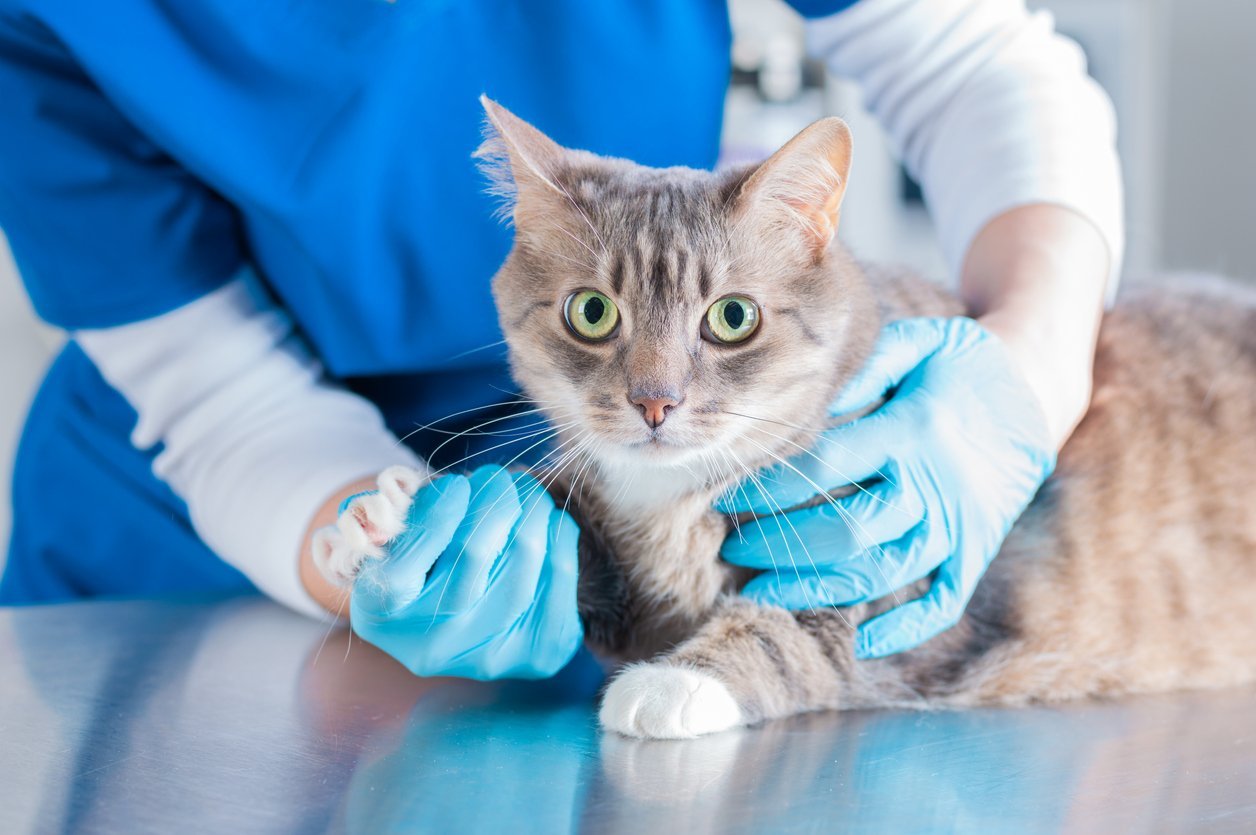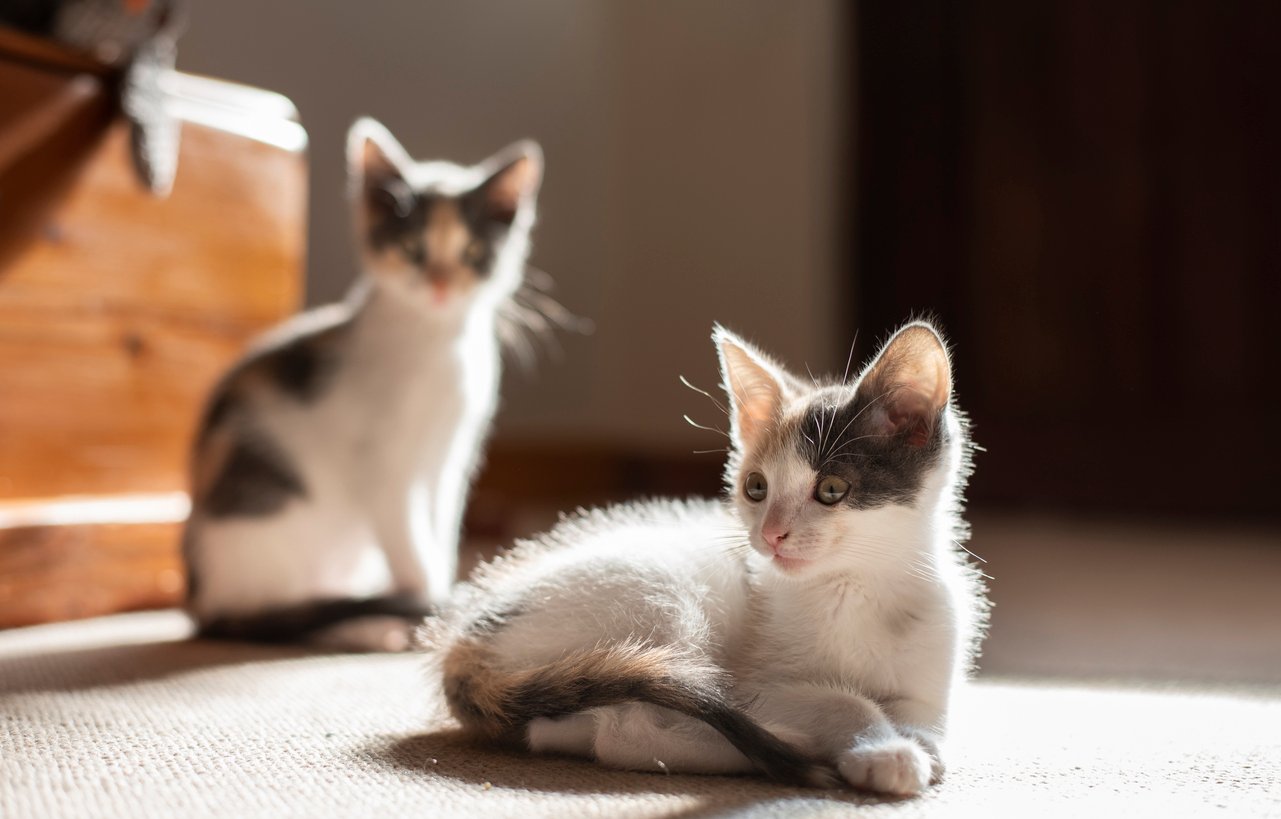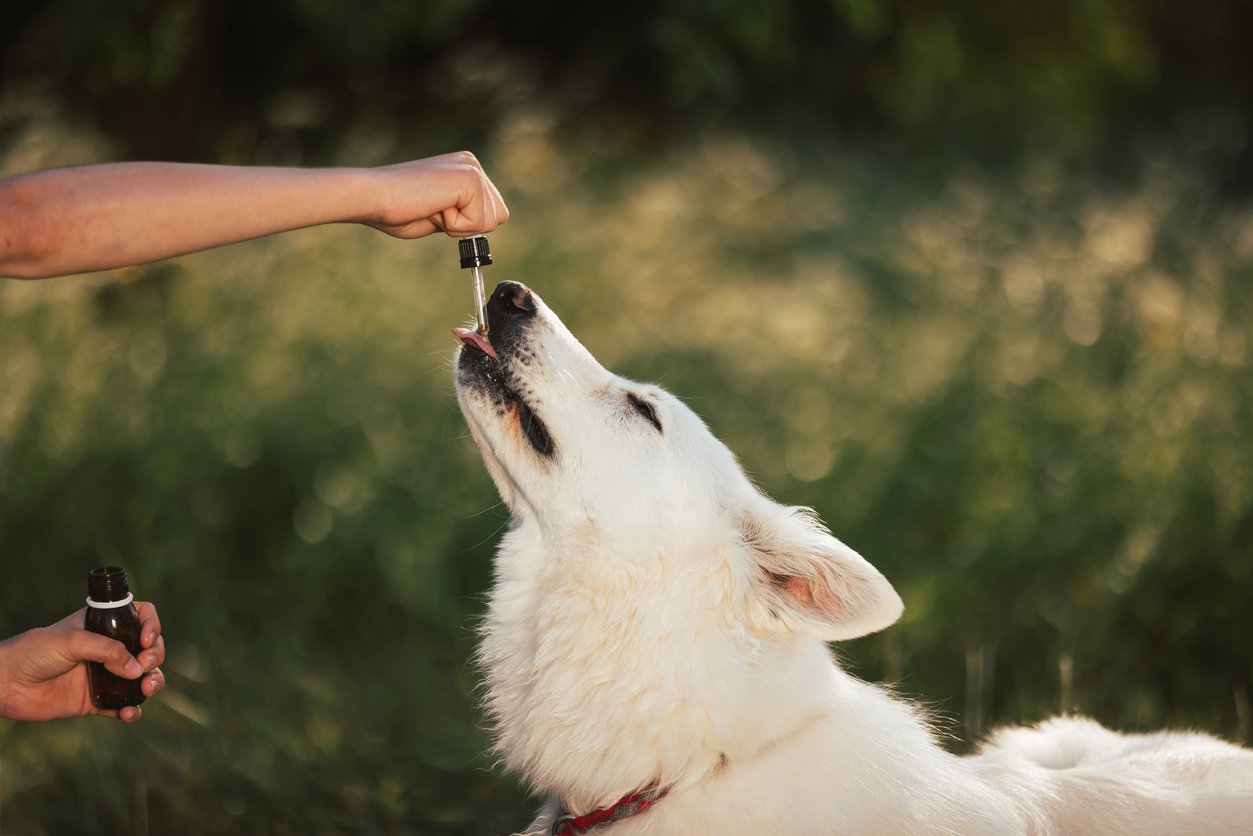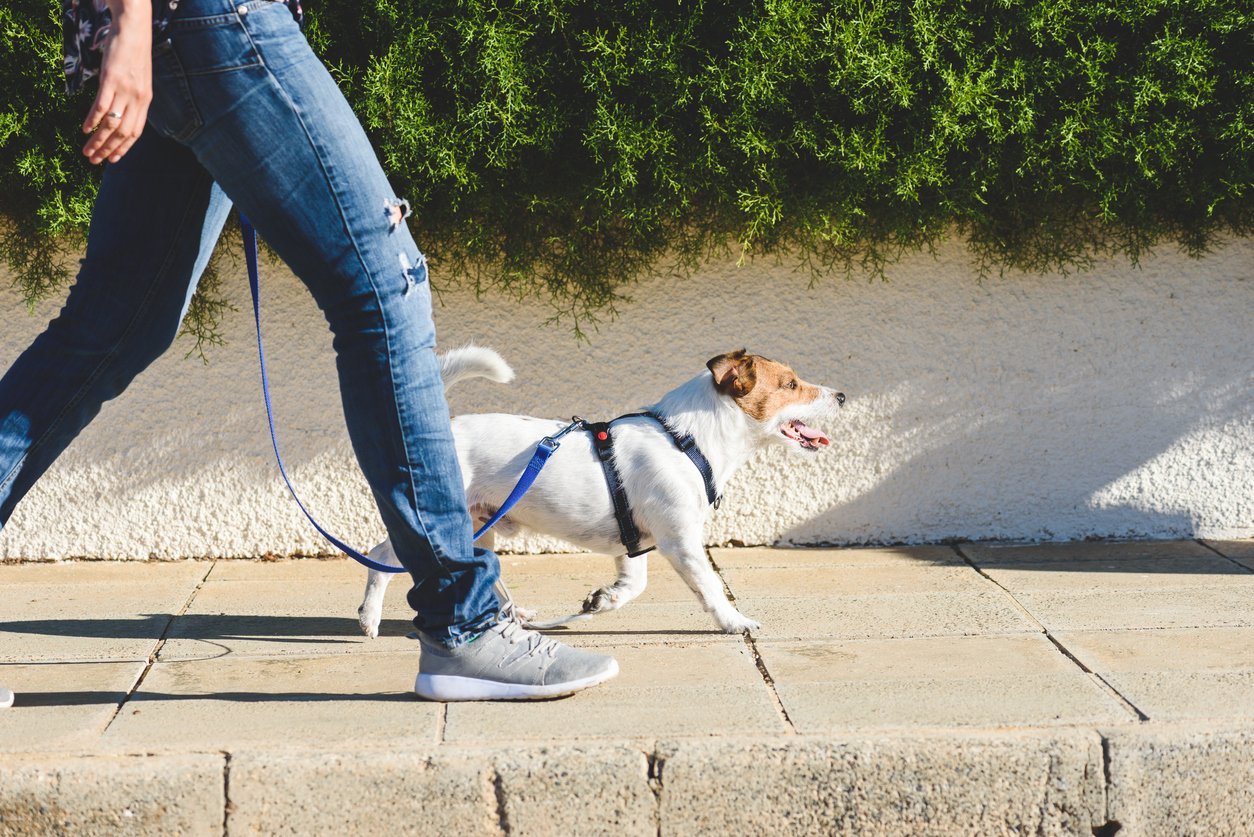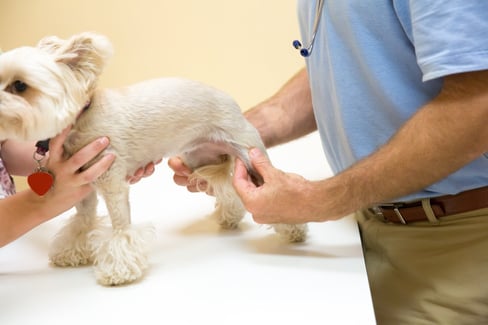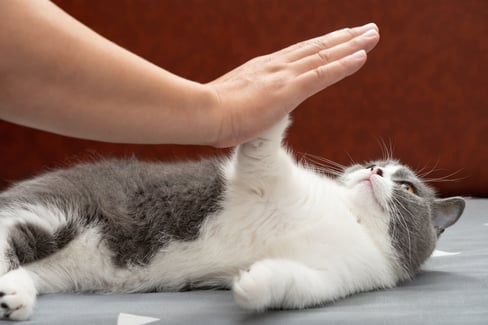Table of Contents
Your kitty is nothing short of a furry acrobat.
They love to climb to their favourite spots high in the house to watch the world go by and chase their treasured toys around the house.
But what happens when your cat stops in their tracks, and you notice they aren’t being their normal selves? Maybe you’ve noticed them suddenly hopping and skipping, holding a leg up as they move.
This might be a sign your kitty is dealing with a feline luxating patella.
This condition, while common, can be a headache for your kitties, especially if it goes untreated. It’s important to understand how this condition affects your cat, as well as how cat luxating patellas are treated and what symptoms to look out for — which is precisely what we’ll cover today.
What is Luxating Patella in Cats?
Luxating patella cat problems occur when the patella slips out of place. The patella is also known as your cat’s kneecap and is one of the most important parts of their knee — it allows them to run, jump, and flex their little legs so they can their favourite spots.
The diagram below indicates where you can see the patella and other important parts of the knee. Note that in a properly working knee, the patella slots into the trochlear groove, and the patellar ligament acts as a pulley, lifting the patella up and down in the groove. When the patella slips out of the groove, that is what you call a cat luxating patella.
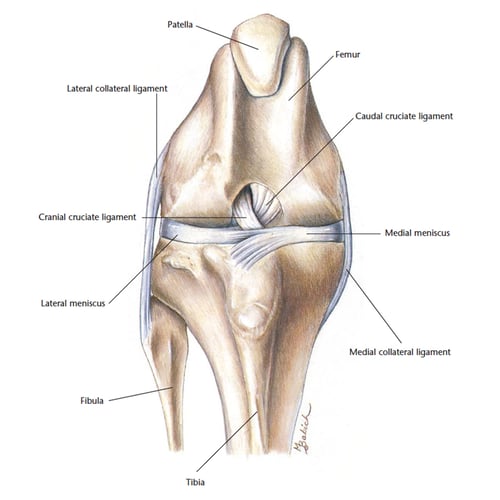
So you can imagine that having that crucial piece of your cat’s knee puzzle slip out of place could lead to some problems.
A luxating patella cat can be caused by an injury, or more likely, it is congenital. This means that your kitty is born with it and that it is likely hereditary, thanks to their breed.
Breeds most commonly afflicted with luxating patella in cats include:
- Abyssinian
- Burmese
- Devon Rex
If your cat has a luxating patella, you may see them skip on one of their legs for a few steps after running or jumping. Your kitty may also hold that leg up for a minute before putting weight on it again. Some cats with luxating patellas will have difficulty climbing stairs and may even hop up them to avoid putting strain on their knees. Luxating patellas are rarely painful initially, but can eventually cause pain and arthritis if left untreated.
Feline Luxating Patella Diagnosis
The first step in a feline luxating patella diagnosis is to observe your feline friend for symptoms of luxating cat patella. The first and most obvious sign is the “skipping” motion that cats with luxating patellas experience. You’ll see the strange hopping or skipping most often when they are running or jumping, and once you see that, it’s time to call the vet.
Other common signs you may see in a cat with luxating patella include:
- Cat limping in one or both hind legs suddenly or intermittently
- Bringing the rear leg up toward the body frequently
- Lack of willingness to jump and climb
- The affected legs seem stiff
- A bow legged gait (common in cats who have medial patellar luxation)
To confirm a diagnosis of luxating patella cats, you’ll need to visit the vet. They are the experts at diagnosing the problem and offering a treatment plan for your poor kitty.
Once you arrive, your veterinarian will likely give your cat a thorough physical exam, including palpation (feeling the affected area) of the leg muscles and joints. During a physical examination, your vet can determine whether your cat's kneecap can be manually luxated.
This test may not always be conclusive because it requires that your kitty’s knee flexes when pressure is applied during the test.
That’s why your veterinarian may choose to use some other diagnostic tools. This can help to evaluate other concurrent issues with the bones around the knee and to confirm the luxating patella cat problems diagnosis.
The diagnostic imaging that may also be done to determine if your cat has a feline luxating patella:
- X-rays
- Arthroscopic exam (where a camera is inserted into the patellar groove)
- MRI
- Ultrasound
The results will help your veterinarian determine what kind of luxation your cat has, which helps determine treatment options as well as prognosis.
Types of Luxating Patella Cats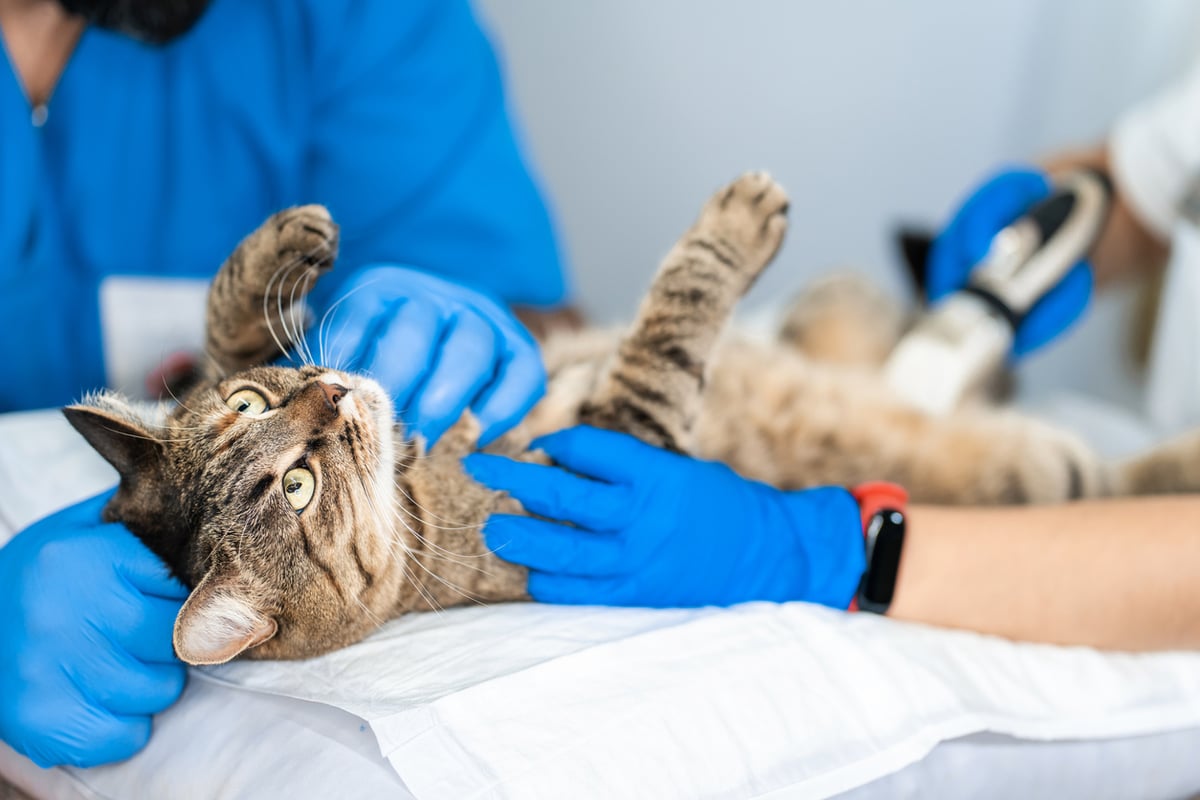
There’s more than one type of luxating patella in cats. It depends on where the luxation occurs and how severe it is.
Your vet will help you determine what type of luxating patella in cats your kitty is affected by and create a treatment plan based on their needs.
1. Medial Luxating Patella in Cats
Medial luxating patella in cats happens when the patella dislocates towards the inside of the knee. This is the most common form of cat luxating patella.
Either way, the condition can be congenital (present at birth) or acquired (develops later) from trauma.
Congenital patellar luxation in cats may happen due to various genetic defects of their limbs and structures, such as:
- Femur
- Stifle joint
- Tibia
- Trochlea
Degenerative joint disease can also lead to the "warping" or misalignment of this joint, causing the kneecap to pop out of place. And while a cat luxating patella is not necessarily painful at the outset, there will likely be chronic inflammation and the signs of cat arthritis inside the knee if the cat luxating patella is left for a long time without treatment.
2. Lateral Patellar Luxation
A lateral luxating patella in cats means the patella in your kitty’s knee dislocates towards the outside of the knee. This is less common than a medial luxating patella, though it is basically the same concept. The difference is where the patella slides in the stifle when it pops out of place on the thigh bone.
The stifle joint where feline luxating patellas occur has two bones to know:
- Femur
- Tibia
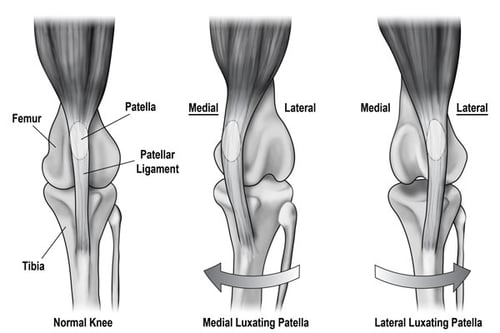
The femur bone is located on the top, and the tibia bone is located at the bottom, which forms a cavity between them (called the trochlear groove, as we mentioned before). The patella or kneecap sits in this cavity. A ligament attaches to both sides of this bone (medial and lateral attachments) and holds it in place when a cat flexes its stifle joint.
Depending on the more affected side (medial or lateral) and where the patella pops out, your kitty will experience either a medial or lateral cat luxating patella.
3. Luxating Patella Grades
A cat with luxating patella can be anywhere between very mild and very severe, and the treatment and outcomes applied to your kitty’s needs will depend on the severity of their luxating patella cat problems.
Luxating patellas in cats can be classified into four degrees, with the higher degrees being more severe, as outlined in the table below.
| Luxating Patella Cat Grade |
Description |
| Grade I |
When pressure is applied to the patella, it will slip out of its groove, but it will return to its original position once the pressure is released. |
| Grade II |
Occasionally, the patella comes out on its own. As soon as the leg is hyperextended and rotated, it returns to its groove. |
| Grade III |
The patella is usually out of the groove but can be pushed back in manually. |
| Grade IV |
There is no way to reposition the patella manually because it has come out of its groove permanently. |
Luxating Patella In Cats Symptoms
There’s nothing worse than seeing your fur baby in pain. But how do you know that it’s luxating patella you’re dealing with and not something else?
There are a few surefire signs that your cat is suffering from luxating patella, such as intermittent lameness. Let’s go over some common luxating patella in cats symptoms in more detail.
Intermittent Lameness
Trouble walking, running, or jumping is one of the primary signs of luxating patella cat problems. Typically, you’ll notice that your cat is suddenly uninterested in walking or has difficulty moving. If you notice this symptom, it could be a sign that you’ve got a luxating patella cat on your hands.
You’ll notice that, at first, your cat may only suffer from lameness for short periods of time. However, as the disease progresses to Grade III or Grade IV, the lameness may become more frequent.
Skipping on a Leg
Another common symptom of luxating patella cat is if your fur baby is skipping on one of his legs. This usually looks like your cat walking a few steps while holding the paw in the air. Then, he’ll put the cat paw back on the ground as if nothing happened and take a few more steps.
Limping
Another key sign that your kitty is dealing with luxating patella is if you notice him limping. Remember that cat limping can also be caused by other issues, so it’s a good idea to check your kitty out at the vet.
Vocalizing
When cats are hurt or in pain, they’ll often meow or yowl to let us know. If you notice your cat is vocalizing more than usual, especially while limping or hobbling, it could be a luxating patella cat that’s causing the problems.
Lack of Appetite
When our kitties aren’t feeling their best, they may not be so interested in food. That’s because they’re in pain and are more worried about feeling better than eating. If you notice your cat has stopped eating and shows one of the other symptoms of luxating patella cat, that could be what’s to blame.
Cat Luxating Patella Prevention 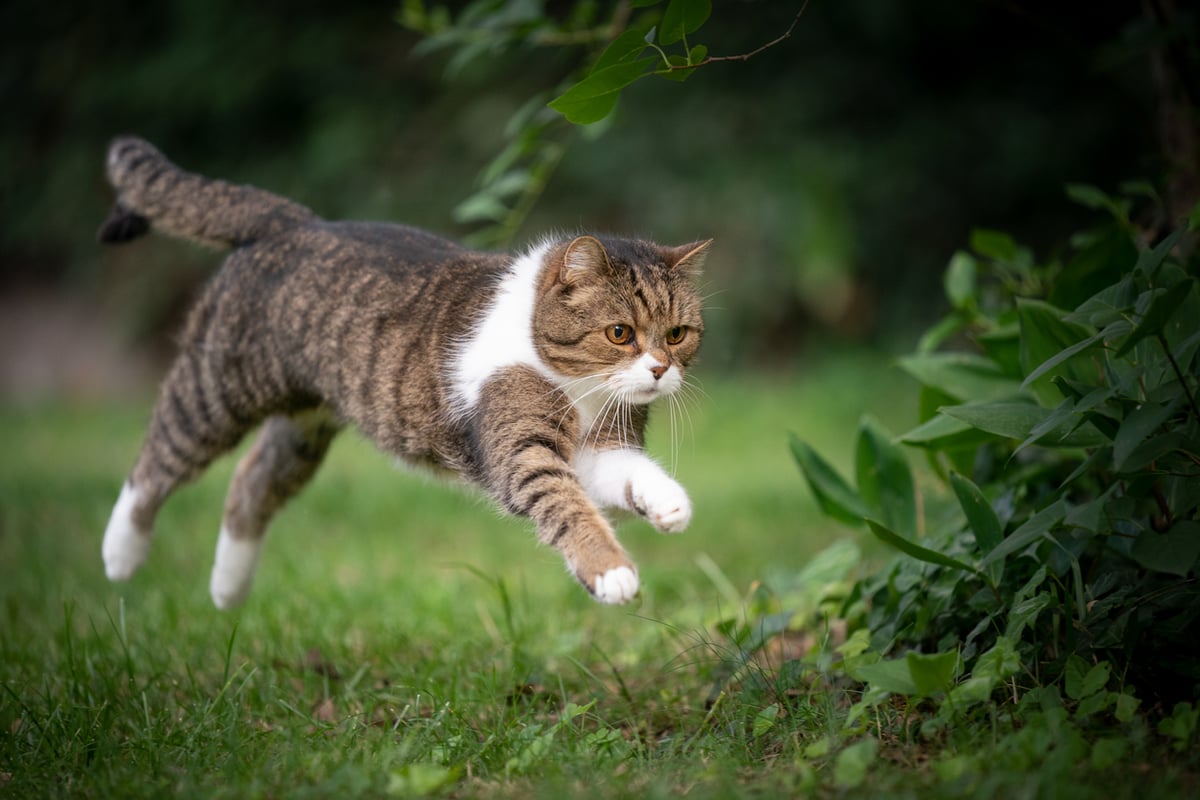
Like any good cat owner, you want to make sure you protect your kitty from unnecessary pain and suffering.
The thing is, you can’t 100% prevent a cat from luxating patella. It’s largely a hereditary disease and can’t be avoided in cats predisposed to it based on breed and family history.
That said, you can do things to strengthen your cat’s soft tissues and joints and maintain good overall pet health for the best chance at avoiding painful repercussions from cat luxating patellas.
Let's get into the tips for preventing feline luxating patellas.
Joint Supplements
As we said, we can't 100% prevent your kitty from getting a luxating cat patella. But one of the best ways to build strong, supportive soft tissues and muscles is to feed your fur baby a cat joint supplement.
Taking joint supplements will help your cat's joints, including their knees, feel stronger and healthier. In cats genetically predisposed to luxating cat patellas or those with arthritis, this is particularly paramount.
Cartilage wears away over time, leading to the development of this degenerative condition. When this happens, your cat's bones rub against one another, causing inflammation and pain over time.
However, some active ingredients can maintain the health of your joints to prevent arthritis.
You should look for a joint supplement for luxating cat patellas that includes:
- Glucosamine: Restores cartilage that has been damaged
- Chondroitin: Lessens cartilage deterioration
- MSM: Pain-relieving and anti-inflammatory
One cat supplement that has those ingredients? TRI-ACTA for pets. This 100% pure formulation is third-party batch-tested and Health Canada-approved, so you can trust the quality for your precious pet. This is an important supplement to consider to prevent joint issues like luxating patella.
TRI-ACTA for Pets
A proactive approach for developing and younger adult pets to maintain optimal joint health mobility, minimize inflammation and fend off age-related ailments.
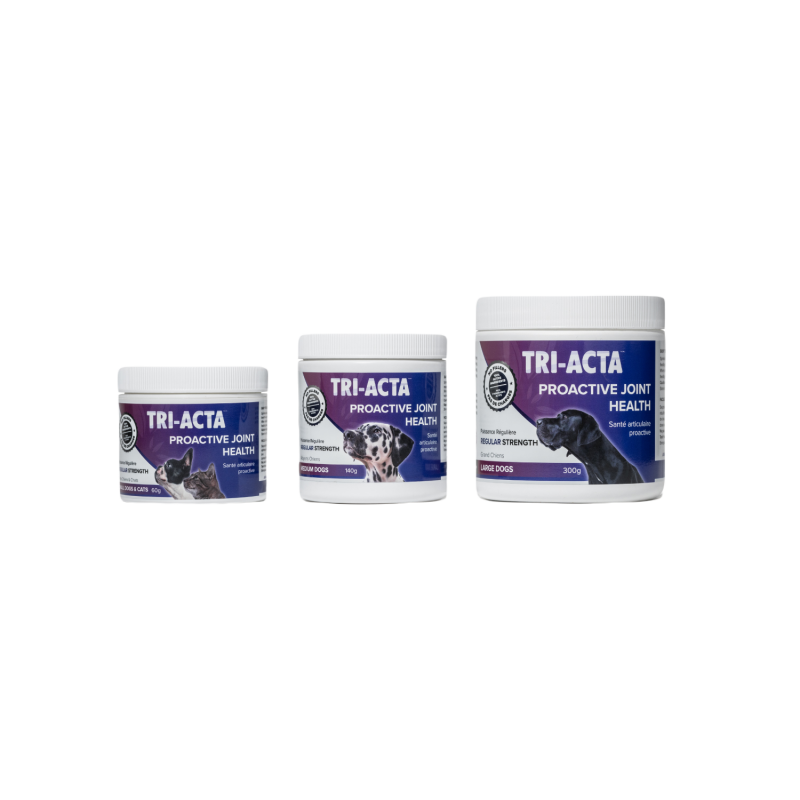
Screening
The only true prevention for cat luxating patella is ensuring the hereditary trait doesn’t get passed down. And how do you do that? You screen it out.
If you’re hoping to make sure your kitty has the best chance at not experiencing luxating cat patella problems, then you need to look for a breeder who can tell you the family history of your kitty. This is especially important for breeds like Burmese and Cornish Rex, who are more prone to the condition.
A cat luxating patella can only be “screened” informally. In spite of the fact that patellar luxation seems to be an inherited condition, joint problems have complex inheritance patterns and are multifactorial, so there are no genetic tests available for this condition yet.
If you already brought home your sweet kitten, and if they are a mixed breed or one of the breeds we’ve mentioned as likely carriers, make sure you take them to the vet on time and regularly throughout their young life. That way, your vet can consistently check for physical signs of patellar luxation, and you can get on top of treatment early.
Weight Management
Maintaining good overall cat health can solve many of your kitty’s health woes. By keeping them in good shape and at a healthy weight, you can ensure they have the best chances to reduce the pain and onset of luxating patella cat problems.
Why exactly?
Consider this: a cat with a heavier overall body will bear more weight down its joints. They are also less likely to exercise enough every day, leading to stiff, sore muscles and cat joint pain when they take that big leap occasionally. This extra stress on their joints can cause arthritis and degeneration of the cartilage in their joints, thanks to the weight bearing down on them 24/7.
So, as much as we like rewarding our kitties with plenty of treats, that can be a big contributor to obesity in cats, and when you are trying to prevent a luxating patella in cats from getting worse, it’s even more critical to manage their weight.
When it comes to your feline’s diet, you could opt for a specialty diet like a cat raw food diet, but even better is choosing a scientifically formulated food focused on weight management.
To avoid feline luxating patella symptoms, these foods are balanced to include the proper nutrients your kitty needs to maintain good body condition, including:
- Vitamins
- Minerals
- Fish and meat proteins
- Fatty acids
- Amino acids
- Fiber
By feeding a weight management diet that’s properly balanced by the pros, your kitty will get exactly the right amount of calories and nutrients and keep those pounds off.
Also important to weight management is exercise.
And we know that cats love napping in their favourite sun puddles more than anything, and getting them to move can be tricky!
The thing is, it’s super important to get your kitty moving, and you may even find it to be a great bonding time for you and your fur baby. Ideally, you want to ensure your cat is active for 30 minutes daily.
The table below has some ideas to help keep your cat active and help reduce the onset of a cat luxating patella.
| Cat Exercise |
Ideas & Tips |
| Toys and tools |
|
| Games |
|
| Friendly play |
|
| Environment enrichment |
|
Cat Luxating Patella Treatment 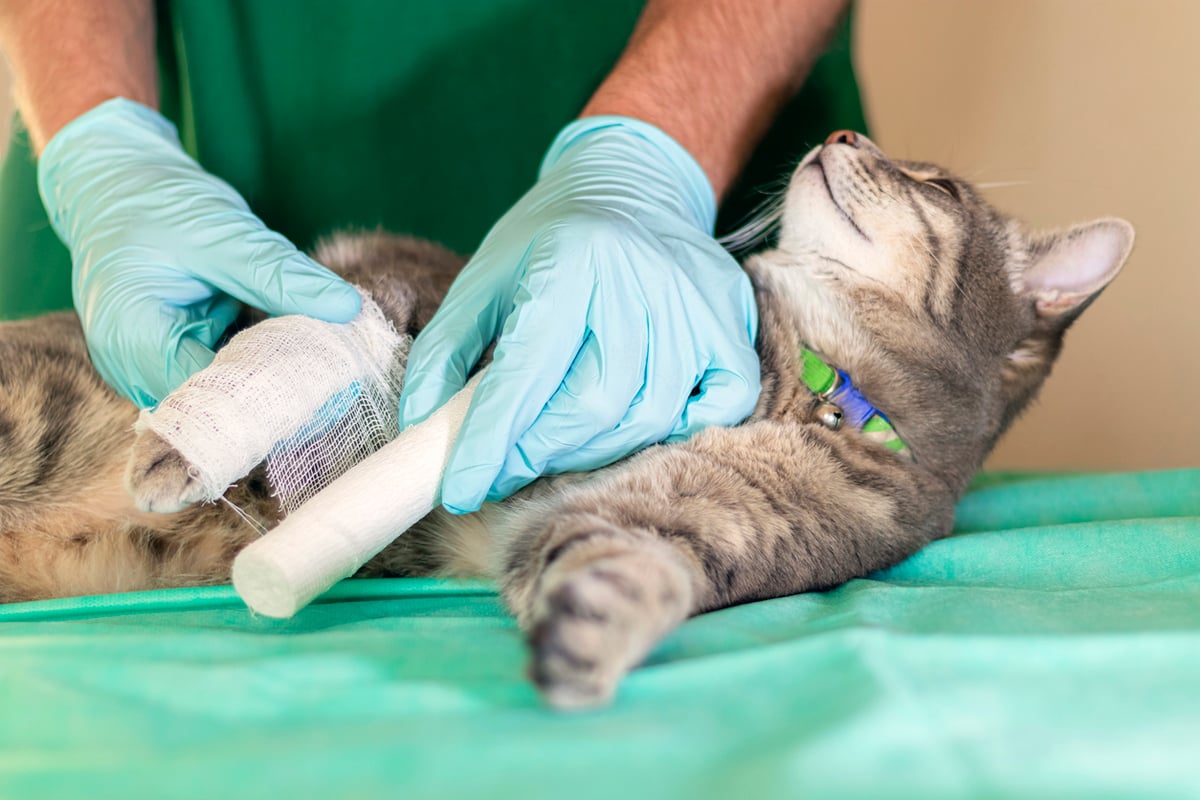
For cats with luxating patellas, the good news is there are plenty of options for treating and managing the condition.
For kitties experiencing a less severe form of feline luxating patella, such as a Grade I or II, conservative treatment is usually recommended as a first course of action. Your vet will be able to design a plan suited to your feline’s needs, but it usually includes rest, exercise restrictions, and, sometimes, anti-inflammatory medications.
This is also a case where a cat joint supplement can come in handy. Joint supplements, like TRI-ACTA H.A. can help reduce pain and inflammation as well as help repair and protect cartilage. This is crucial because feline patellar luxation, if left untreated, can cause arthritis and other joint problems, like cruciate ligament tears. Building a strong foundation of healthy soft tissues and joints can delay or even prevent the onset of cat arthritis.
Surgical treatment may be needed if conservative therapy doesn't work and your cat is in a lot of pain and can’t get around comfortably, and therapeutic supplements like TRI-ACTA H.A. can also aid in surgery recovery (remember how we mentioned it reduces pain and inflammation above?). For Grades III and IV patellar luxations, this is often the case. The goal of surgery is to keep the patella in its groove and to stabilize the kneecap. This is done in a few different ways, and the right method will be recommended by your veterinarian after they evaluate their condition.
The table below shows the types of surgery your vet may consider for cats with severe feline luxating patella.
| Cat Luxating Patella Surgery Type |
What It Is |
| Tibial Tuberosity Transposition |
During this surgery, the patellar ligament is moved medially or laterally on the proximal tibia to help keep the patella aligned in the trochlear groove. |
| Retinacular Release & Tightening |
This procedure aims to help maintain the patella in the trochlear groove by modifying the parapatellar soft tissue tension. Except in cases of traumatic patellar luxation, this technique is typically used in conjunction with other corrective surgeries. |
| Trochleoplasty |
When a cat's got a very shallow trochlear groove, a trochleoplasty procedure is recommended to deepen the trench, so the patella can properly slide in and out. There are various techniques for doing a trochleoplasty, such as the block recession method. Which is best for your cat should be determined by your vet. |
Cat Luxating Patella Surgery Cost
Surgery is often a solution for a cat patella luxation. Regarding the average cat luxating patella surgery cost, you can expect to pay between $1,000 and $5,000 per knee. The exact cost of the surgery will, of course, depend on the severity of the cat patella luxation, the locality you live in, and your vet’s practice.
The good news is that if this cost seems too steep, many vets accept pet insurance. That way, you can get some of your costs covered to help ease the burden of caring for your kitty.
Luxating Patella Cat Recovery Time
It’s important to make sure the cat luxating patella surgery recovery goes smoothly for a successful long-term outcome. Following surgery, you must closely follow your veterinarian's instructions concerning activity restrictions and containment so that the injured area can heal properly and your kitty doesn't open up stitches.
If you follow the post-op cat luxating patella instructions carefully, the recovery time for a luxating patella operation is usually about 6 weeks. Your cat will be fitted with a bandage to keep the patella in its new position, but remember that you may need to help your cat keep the leg in place, especially when using the litter box.
You will also need to keep the incision site clean and dry and give your cat any medication they may have been prescribed after surgery.
The most common medications prescribed to cats recovering from feline luxating patella surgery include:
- Nocita (a local anesthetic that numbs incision area)
- Buprenorphine transmucosal (pain management medication)
- Non-steroidal anti-inflammatory (pain and inflammation management)
- Antibiotics (to reduce the likelihood of infection)
If your sweet kitty seems to be acting off, is suddenly vomiting, or is lethargic or groggy for more than a few days post-op, call your veterinarian for advice to make sure they aren’t having a bad reaction to the medication.
Once your kitty has completed their course of medication and is working on some physical therapy or stretching exercises (however reluctantly), adding in an extra-strength joint supplement like TRI-ACTA H.A. can help your cat return to normal and keep their joints healthy.. The addition of hyaluronic acid to our regular strength formula helps promote improved synovial fluid and better mobility. That way, your kitty can return to their old selves quickly, and you can enjoy healthy and happy years to come.
TRI-ACTA H.A. for Pets
Our maximum strength formula is optimally designed to accelerate the formation of cartilage, minimize inflammation, expedite the healing process, and improve joint conditions.

Luxating Patella Cat Brace
After surgery, your vet may recommend your cat wears a luxating patella cat brace. This brace can help speed up luxating patella cat recovery time because it helps keep your cat’s limbs in place.
Even if your pet doesn’t need cat luxating patella surgery, a luxating patella cat brace can help provide limb support that allows the issue to heal itself. Just remember — don’t assume that the brace will replace surgery unless a vet has already suggested this might be the case. It’s always best to get a vet’s opinion first to make sure you’re helping your kitty in the best way possible.
Q&A
Understanding cat patella luxation can be tough, so we’ve put together a couple of common questions and answers to help you out. Here’s what you need to know about luxating patella cats and how to treat the condition.
How Common Is Luxating Patella In Cats?
Luxating patella is actually not a common disorder in cats at all. It’s typically associated with certain breeds, such as the Devon Rex, since it’s a genetic disease. However, some cats can still get this disease even if they aren’t a normally at-risk breed, so knowing what to look out for is important.
Can A Cat Live With Luxating Patella?
If the luxating patella cat is only at Grade I of the disease, your cat can often live with the condition for many years without issue. However, this condition is still uncomfortable for your cat, and issues such as cat arthritis and other cat mobility concerns that may occur as your kitty ages can eventually cause the cat patella luxation to worsen. This can cause pain and joint issues and is often irreversible.
Can A Cat With Luxating Patella Heal Itself?
Grade I cat patella luxations can actually reverse themselves. However, higher grades of patella luxation typically require treatment. It’s best to consult with your vet to ensure you’re getting your kitty the treatment he needs rather than assuming your cat’s patella luxation will improve on its own.
Help Fight Luxating Patella Cat Problems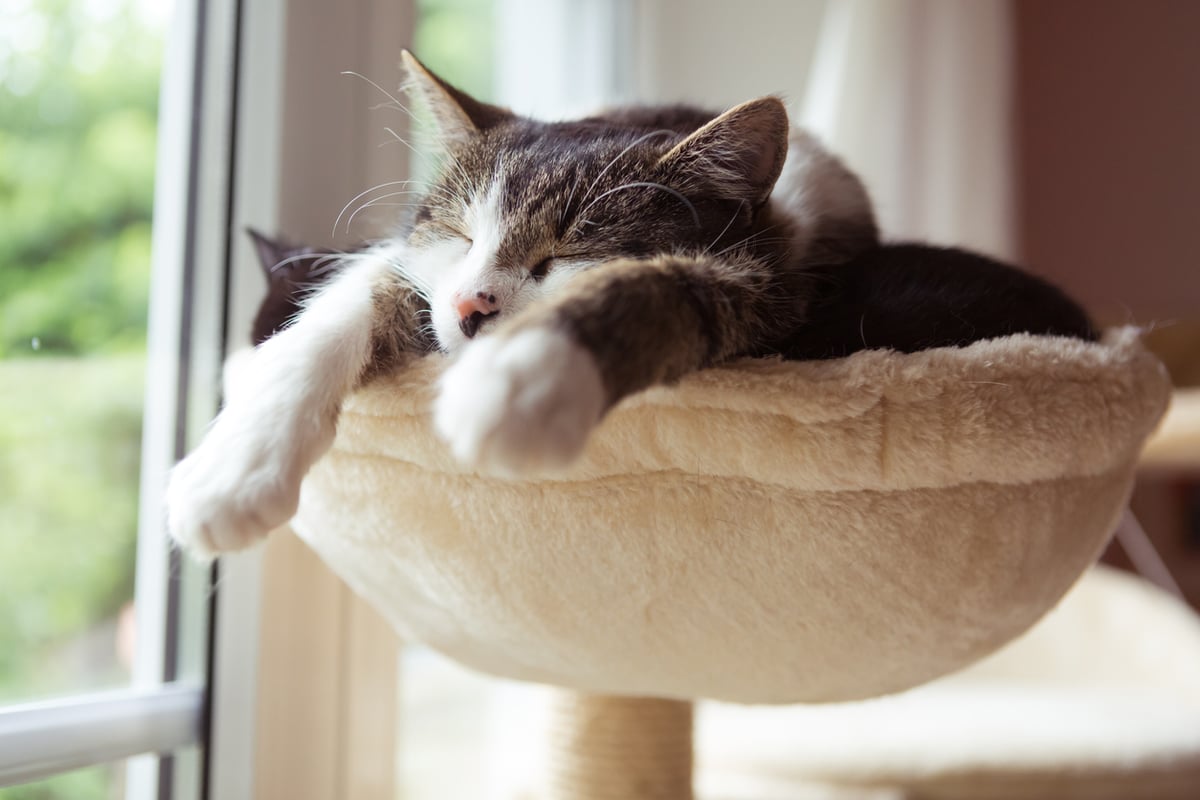
A luxating patella cat condition can be painful and debilitating, but they don’t have to stop an otherwise healthy cat from living a long, happy life. The key to success is early detection and treatment from your veterinarian, as a feline luxating patella is a condition that will likely require surgery. However, some methods of treatment may be able to slow the progression of this condition and improve its symptoms.
And one of the tools you need in your kit to help make that pawsible? Joint supplements.
Cat joint supplements like Integricare’s TRI-ACTA help protect and repair damaged cartilage and reduce pain and inflammation often caused by feline luxating patellas. It contains essential ingredients like glucosamine for cats, Chondroitin, and MSM. And for cats who have had surgery to correct a luxating patella, TRI-ACTA H.A. can help them recover faster and improve their mobility thanks to the addition of hyaluronic acid.
Now that sounds like the purr-fect way to keep your kitty pouncing and playing for years to come.
TRI-ACTA H.A. for Pets
Our maximum strength formula is optimally designed to accelerate the formation of cartilage, minimize inflammation, expedite the healing process, and improve joint conditions.

Newsletter Signup
Subscribe to our newsletter to receive the latest news and exclusive offers.
.jpg?height=2000&name=Cliick_Integricare-DISPLAY-REVISEDV2%20(1).jpg)
Proactive & Therapeutic Joint Supplements
When given daily, Integricare joint supplements recover bone and joint injuries faster and help prevent mobility injuries from happening in the first place.

